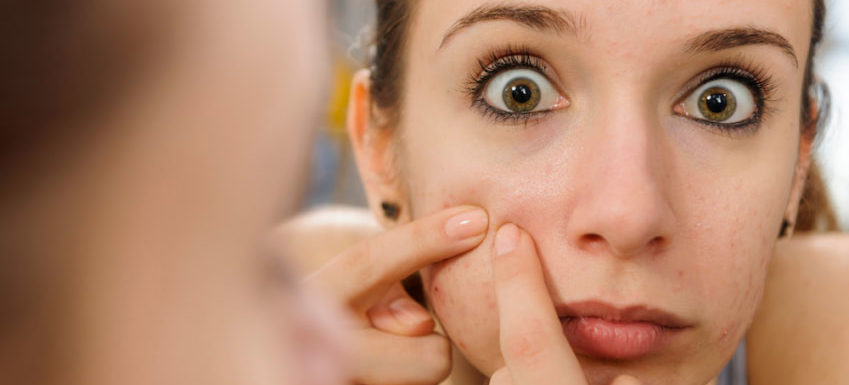Acne is one of the more common skin conditions, affecting hair follicles when they become clogged with dead skin cells and oil. Acne is a broad term that includes the appearance of pimples, blackheads and/or whiteheads. While acne tends to be considered a condition that plagues teenagers, it is not limited to adolescent years. Adult female acne is prevalent with 1%, 35%, and 26% of women report having acne in their 20s, 30s, and 40s, respectively. Depending on the severity of the problem, acne scars the skin and causes emotional distress to the affected person. Acne in adults is classified into three groups: new onset, continuous, and resolved/returned acne.
New Onset Acne
Sudden acne breakouts can have multiple causes, including hormonal fluctuations, pH imbalance, unhealthy diet, excessive stress, and an overproduction of sebum, among other reasons.
Hormones
Women can experience new onset acne just before their periods or around their ovulation time. Pregnancy, postpartum, and breastfeeding can also trigger acne. Hormonal imbalances are more common when women are overweight or have pre-existing health conditions, which may result in the sudden appearance of acne. Hormonal acne tends to present as deep and cyst-like and is often tender or painful.
Contact Irritation
Anything that irritates the skin can lower the skin’s natural defenses and cause a protective reaction that leads to inflammatory acne. Harsh cleansers and abrasive treatments, especially against dry skin, can trigger acne breakouts.
Stress
Excessive emotional stress can create biological changes in the body that can lead to sudden acne breakouts. Women often complain of acne breakouts associated with additional stress in the workplace, when preparing for and taking exams, interviewing, or planning an event, like a wedding. When you’re feeling stressed, anxious, pressured, or scared, your adrenal glands make more cortisol, the stress hormone, which can lead to a skin imbalance.
Physical stress can also trigger hormonal changes, weaken your immune system, and cause inflammation. Extreme weather, lack of sleep, illness, and exposure to environmental irritants can all be triggers for adult female acne. Allergies and migraine may also contribute to acne, as well as smoking.
Diet
Certain foods, especially excessive white flour products, sweets, dairy, and processed, fried and fatty fast foods, may trigger acne, though experts don’t all agree on this. Overeating may also be associated with acne breakouts and many report experiencing more acne during the Holidays.
Medications
Certain medications have been shown to trigger adult female acne. Some supplements such as Lithium, some anticonvulsants, hormonal pills, and steroids can also cause or aggravate acne. While many contraceptives are used as treatment options for acne, certain formulations may also trigger it.
Continuous Acne
Continuous, or persistent acne is the most common observed in women, seen in 75-85 percent of cases. While women who experience new onset adult acne may or may not have experienced acne in adolescence, persistent acne presents in adolescence and continues into adulthood, sometimes with short periods of remission. The reasons for continuous acne are not fully understood, but external factors including cosmetics, medications, and endocrine abnormalities should all be considered. As with all acne treatments, treatment of continuous acne should aim to reduce sebum, comedogenesis, bacterial growth, and inflammation. Once a successful treatment is found, maintenance therapy is essential to prevent recurrent breakouts.
Resolved and Returned Acne
Often once a successful treatment is found and acne clears, women will find breakouts return in a couple of weeks or months. Acne may return for a variety of reasons.
Lack of Enough Sleep
Sleep greatly affects our overall health. Getting enough and routine sleep can address some of the significant causes of acne, including overactive hormones and stress. Sleep lowers stress levels, prevents the overproduction of cortisol, and in turn, the overproduction of sebum.
Dirty Pillowcase
It is important to launder pillowcases regularly and to wash your face before bed so that your pillow doesn’t become a surface with accumulated oil and dirt.
Dehydration
Water is essential for your bodily functions, and insufficient water intake impedes your body’s capability to self-regulate. This leads to an overproduction of sebum, which clogs your pores. Dehydration also leads to the accumulation of dead skin cells, which in turn clog pores. Reducing alcohol and caffeine and avoiding sun exposure can also help decrease dehydration. When spending time in the sun, don’t forget to drink more and to wear SPF 30+ sunscreen to prevent sunburns.
Treatment of Adult Female Acne
Often, new onset adult female acne can be treated by at home remedies. No matter what treatment option you choose, it is important to cleanse your skin twice a day to remove makeup, dirt, and oil that accumulates. Avoid harsh and aggressive products that may trigger instead of treating acne, and don’t forget that it’s always worthwhile to discuss home remedies, over-the-counter products, and prescription options with your dermatologist.
To avoid continuous acne after finishing your treatment, limit excessive stress. Excess cortisol, the stress hormone, triggers the production of excess sebum. While sebum is essential for skin hydration, it clogs skin pores when in excess.
Diet can also be the cause of persistent or returned acne breakouts. Investigating your reaction to certain foods may be worthwhile. Avoiding highly processed foods is good for our overall health, especially the health of our skin.
Causes of adult acne vary and treatment options need to be customized for individuals. If you suffer from adult acne, contact our office today to make an appointment with Dr. Kaplan and the team at Adult and Pediatric Dermatology.

